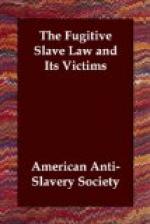was postponed from time to time, when Judge Paine,
with evident reluctance, decreed the freedom
of the slaves. E.D. Culver and John
Jay, Esqs., were counsel for the slaves. The
merchants and others of New York subscribed and
paid Mr. Lemmon the sum of $5,280, for loss of
his slaves. The New York Journal of Commerce
was very active in raising this money. The
same men were invited to contribute something for
the destitute men, women, and children claimed
by Lemmon. The whole amount given by them
all, was two dollars. About one thousand
dollars were raised for them among the better disposed
but less wealthy class.
THOMAS BROWN alias GEORGE BORDLEY, Philadelphia, November, 1852, was claimed by one Andrew Pearce, Cecil County, Maryland. Given up to claimant by Commissioner Ingraham. The arrest of the man was made by the notorious kidnapper, George F. Alberti. Mr. Pettit, counsel for the claimant.
[Transcriber’s note: The following note is inserted after the following section but does not refer to any specific reported incident.]
—> The Slaveholders of Kentucky begin forming associations for mutual protection against loss of runaway slaves. The preamble of the plan of association proposed at a meeting at Minerva Kentucky, held in the winter of 1852-53, is as follows:—“Whereas it has become absolutely necessary for the slave-owners of Kentucky to take such steps as will secure their property, we, the citizens of Mass. and Bracken counties, do recommend,” &c. [end note]
RICHARD NEAL, free colored man, kidnapped in Philadelphia and carried from the city in a carriage towards Maryland. A writ of habeas corpus was obtained, the kidnappers were overtaken, and Neal brought back after resistance and various hindrances. The Supreme Court of Pennsylvania discharged him. February, 1853.
Ten slaves, arrested in Indiana, and taken back to Tennessee, by W. Carney and others. Resistance was made, and W. Carney “was very badly injured during the fracas.”—Nashville ——, March 5, 1853. [Transcribers’ note: —— substituted for word cut off on original page.]
Alton, Illinois. A man claimed to belong to Walter Carrico, of Warren County, Missouri, was arrested by police officers from St. Louis. After being lodged in jail in St. Louis he made his escape, and again went into Illinois. He was pursued, found, and taken back to St. Louis.—St. Louis Republican, March, 1853.
AMANDA, a slave girl, was brought to St. Louis, from near Memphis, Tennessee, a year before, by a son of her master, and by him set free, without his father’s consent. After the father’s death, an attempt was made to seize Amanda, and take her back to Tennessee without trial. This was prevented by officers, the girl taken from the steamboat Cornelia, and brought before Levi Davis, United States Commissioner.




